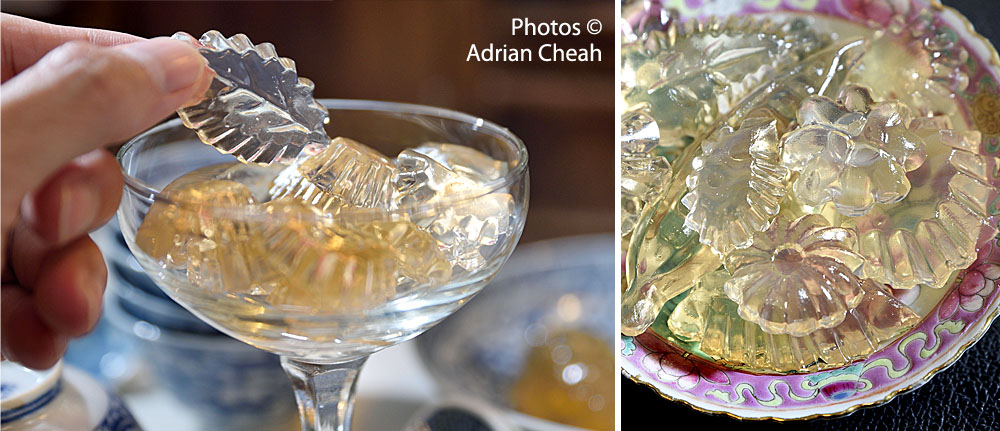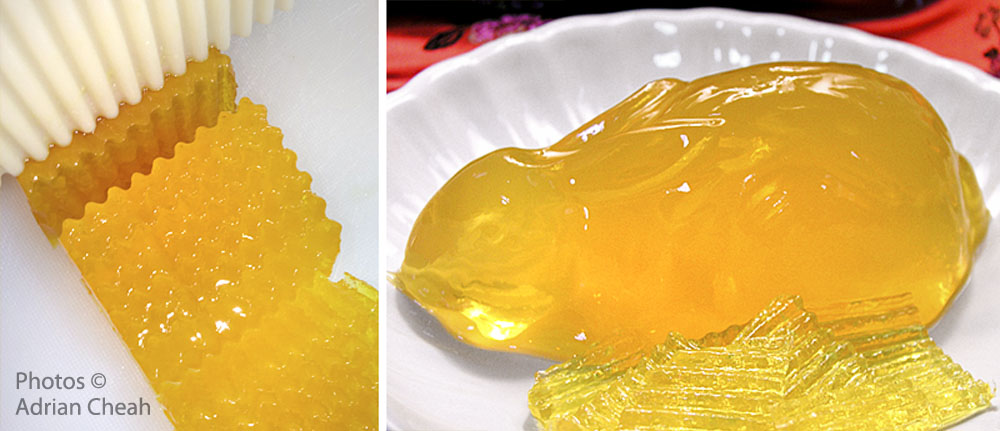Chio Hua, the golden Nyonya Jelly

Reminiscing about my childhood days brings back fond golden memories especially about the kitchen where I first fell in love with cooking. For me, everything that my Mum shared with me will always have a special place in my heart – from cooking the most fiery sambal babi to making crunchy Nyonya jelly (commonly known as chio hua/cheok hwa). Mum has definitely enriched my childhood with these experiences.

Mum would use crushed egg shells while cooking the Nyonya jelly to gather up the froth from the surface. Constantly stirring the pot, she would sweeten the jelly with rock sugar. Then some yellow colouring would be added to the pot to produce a beautiful golden hue. Some believe that using a brass pot would add colour to the jelly but I am rather sceptical about this. Finally, she would add in some rose essence to perfume the jelly before pouring the mixture into moulds, allowing them to set and harden at room temperature. I adore the jelly moulds Mum would use, especially the large aluminium crouching rabbit moulds over the porcelain ones.


In Penang, the chio hua jelly on sale usually are crystal clear with only a very faint golden hue. Mum noted that one can caramelise the sugar first before adding it to the jelly to obtain that shade, sans any colouring. Cooking the jelly over a long period will also help to strengthen the caramelised colour. I love Mum's version and her golden jelly looks more appetising than the commercial ones. Furthermore, the jelly available for sale is often flavoured with vanilla essence, whereas Mum would add rose essence. When it comes to texture, Mum's version wins hands down because of its satisfying crunchy texture.

When making this jelly nowadays, I would scoop two tablespoons of the liquid jelly into a saucer to test for doneness. I would also check the sweetness, adding in more white sugar if needed.
To achieve a more "crunchy" texture, Mum would sun the jelly for a few days before serving it. With this method of preparation, the jelly could be kept in the refrigerator for a longer period of time, although needless to say, with eight children in the house, it would soon vanish.

To prevent ants from consuming the jelly when it is being sunned, Mum would place the moulds in huge, round aluminium trays filled with water below them. Nothing was done in moderation in my family house. Huge trays were needed to sun so many jelly moulds!
Mum would make the jelly during the Chinese New Year season and would distribute them, along with her much sought-after sugee cakes and tins of back-breaking kuih kapit, as gifts to relatives, friends and neighbours. Those days are now all gone but with umpteen years of practice in the kitchen, I am happy that I can easily whip up something delicious even with humble ingredients, all thanks to Mum.

To serve, slice the jelly thinly with a crinkle cutter knife. Above is a closer look at the golden rabbit jelly which is just too pretty to cut into. But cut into it we must in order to relish this golden wonder. The jaw-jerking crunchiness will resound in between your ears with every bite as the sweet delight titillates your palate and rose fragrance envelopes the eating experience.
If you have not tried this, you must! Better still, take time this Chinese New Year and make some chio hua. It is super duper easy to make!
Ingredients:
1.7 litres of water
50 g jelly powder (or good quality agar-agar strips)
200 g white sugar (or according to taste)
260 g rock sugar
70 g raw cane sugar
1 tsp rose essence
1 tsp yellow colouring
Method:
1. Bring all ingredients (except colouring and essence) to a boil.
2. Lower heat and stir continuously for about 2.5 hours or until the syrup thickens. Skim the surface to remove froth. (I have skipped adding in eggshells as mum would have done before.)
3. Test for doneness. Also taste and adjust the level of sweetness by stirring in more white sugar if needed before adding rose essence and yellow colouring.
4. Pour into moulds.
5. Cool at room temperature then sun the jelly (if possible).
6. Slice thinly before serving.

During the Chinese New Year season, the chio hua is available in Penang at places like the Pulau Tikus market. This jelly can keep for months in tins stored in the meat safe or in the refrigerator.
---------------------------------------------------------
Written and photographed by Adrian Cheah
© All rights reserved
27 January 2022